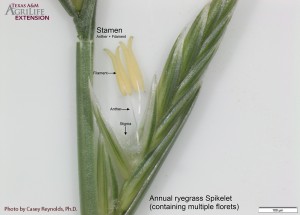Latin Name: Lolium multiflorum L.
Growth Habit: Bunch-type
Vernation: Rolled
Leaf: Ridges on upper surface; smooth and glossy on lower surface
Ligule: Membranous, rounded
Auricles: Claw-like
Inflorescence: Spike with many spikelets; multiple florets per spikelet
Description: Annual ryegrass is an annual, cool-season turfgrass with a bunch-type growth habit. It is primarily used to overseed warm-season species to provide winter color, but can also be found in home and garden centers as part of cool-season mixtures with other species including perennial ryegrass, tall fescue, and Kentucky bluegrass. These mixtures are most successfully planted in the fall and can provide ground cover throughout the winter months, particularly in shaded areas where warm-season turfgrass will not persist. However, annual ryegrass will not persist as a perennial turfgrass due to its annual life cycle and poor heat/drought tolerance.
Strengths: Shade tolerance, cold tolerance, short germination time, tolerant of low mowing heights, and rapid establishment.
Weaknesses: Annual life cycle, coarse leaf texture, light green color, and poor heat and drought tolerance.
Recommended Mowing Height: Because annual ryegrass is only used as an annual crop to overseed warm-season turfgrasses, the mowing height should be determined by the warm-season species being overseeded.
Recommended Mowing Frequency: Every 3-7 days depending on height of cut using a rotary or reel mower.
Fertilization Requirements: 1 to 3 lbs N per 1,000 ft2 per year. Single application rates should range from 0.5 to 1 lb of N per 1,000 ft2 applied during the spring and fall growing season.
| Available Annual ryegrass Varieties in Texas | ||
| Variety | Latin Name | Availability |
| Many available | Lolium multiflorum L. | Seed |




